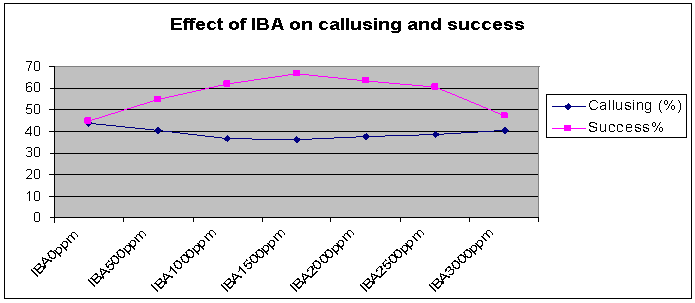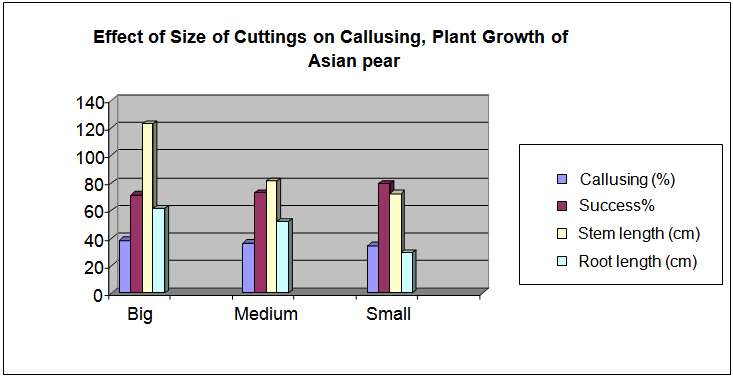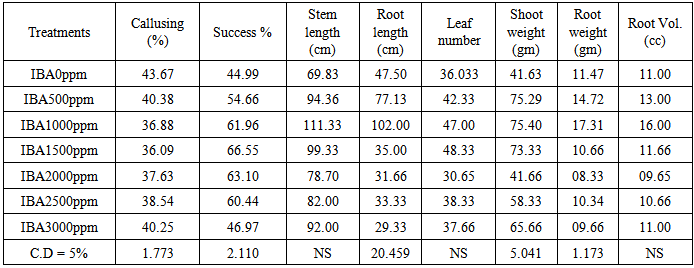-
Paper Information
- Next Paper
- Paper Submission
-
Journal Information
- About This Journal
- Editorial Board
- Current Issue
- Archive
- Author Guidelines
- Contact Us
International Journal of Plant Research
p-ISSN: 2163-2596 e-ISSN: 2163-260X
2015; 5(3): 64-67
doi:10.5923/j.plant.20150503.03
Efficacy of IBA and Determination of Cuttings Size in Asian Pear (Pyrus pyrifolia L.)
B. R. Jana , Bikash Das , S. Kumar
Horticulture & Agroforestry Research Programme, ICAR Research Complex of eastern Region, Ranchi, India
Correspondence to: B. R. Jana , Horticulture & Agroforestry Research Programme, ICAR Research Complex of eastern Region, Ranchi, India.
| Email: |  |
Copyright © 2015 Scientific & Academic Publishing. All Rights Reserved.
An outdoor propagation trial was conducted to study the effect of Indole Butyric Acid (IBA) on rooting success of cuttings of Asian pear( Pyrus pyrifolia L.) to provide enough quality planting material to the farmer. The woody cuttings (20 cm in length) from the basal, middle and apical portions of the branches were taken from current season growth by pruning. The bases of the dried cuttings were immersed in a solution containing fungicide benomil @ 1% for 30 seconds as disinfectants. Different concentration of solution having IBA contents of 0.00, 500, 1000, 1500, 2000, 2500 and 3000 ppm were applied one set of cuttings for first experiment. In another experiment 1000ppm of IBA was applied in general pear cuttings of three different sizes (small-15cm, medium-20cm and big -25cm) for standardization. The minimum callusing time of 36.09 days was found in IBA treatment at 1500ppm. Treatment accounted for the maximum success per cent (66.55%). The treatment of IBA at 1000 ppm accounted for maximum shoot and root weight of 75.45gm and 17.31 gm respectively from first experiment. The second experiment resulted in lowest day unit (34.58) required for callusing. The maximum success (79.25%) was also found in small cuttings. However, shoot length (122.75cm) and shoot weight 961.25 gm were found in big cuttings. The root weight (13.75gm) was the maximum in medium size of cuttings.
Keywords: Asian Pear, Cuttings and Indole Butyric Acid, Callusing per cent
Cite this paper: B. R. Jana , Bikash Das , S. Kumar , Efficacy of IBA and Determination of Cuttings Size in Asian Pear (Pyrus pyrifolia L.), International Journal of Plant Research, Vol. 5 No. 3, 2015, pp. 64-67. doi: 10.5923/j.plant.20150503.03.
Article Outline
1. Introduction
- Pear (Pyrus spp) is one of the most ancient of cultivated temperate fruit crop in India. Few fruits match a more distinct image than the Asian pear. With its graceful, voluptuous contour, crisp and crunchy texture and less in sugar, it is easily become one of the most provocative sensuous fruits of the world. Due to high productivity, good eating and keeping quality, high nutritive value, Greek poet Homer described it as God’s fruit about 1500 years back. Due to its high adaptability, it is grown in different parts of the world. The cultivation of Asian pear now days are expanding from temperate region to subtropical and tropical region with assured irrigation. According to FAO [1] indicated that India’s pear production about 340.000 tonnes from the area about 38500 ha. It has sandy texture and rounds body crunchy in taste make the fruit eighth in world fruit production being mainly commodity of China [1]. The Eastern plateau and hill region offers ample scope for pear cultivation. The quality planting materials propagated from certified nursery are scanty. True to type planting materials are scarce within commercial growing belt. Availability pear plant through certified nursery in the sub-mountain region is also meagre. IBA efficiently induced adventitious rooting in Arabidopsis stem segment at 10 ppm concentration [2]. Iqbal et al, [3] found that the maximum success per cent (76.67) rooting of apple cuttings were observed when 3000 ppm of IBA was applied. Davin et al, [4] also reported that in apple clonal cutting was most successful under 2500 ppm IBA condition. In pear even 100 ppm IBA treatment for 24 hours causes rooting [5] because of ease of rooting of some cultivars. Divisions of the first root initial cells are dependent on either endogenous or applied auxins [6]. Eastern plateau and hill region offers optimum scope for successful cultivation of low chill pear due its mild climate. Keeping this in view the objective of the study was two folds. First, we wanted to examine the efficacy of IBA in terms of success and plant growth. Second, we wanted to standardize the size of cuttings. These objectives were pooled to produce quality planting materials through cutting successfully. In our experiment under subtropical condition we increase the IBA concentration with minimum time for better result.
2. Materials and Methods
- The experiment was conducted at Horticulture and Agro Forestry Research Program at Ranchi under Indian Council of Agricultural Research Complex for Eastern Region, Patna. This area is situated 620 m above mean sea level and at 23 25’ N latitude and 85 20’ East longitudes with average annual rainfall of 80-140 cm. The experiment was started in January 2004 and extended to June-July of that year. Six different concentration of IBA viz; 0 ppm, 1000 ppm, 1500 ppm, 2000 ppm, 2500 ppm and 3000 ppm were applied on the cut surface of the cuttings. Cuttings were dipped in respective IBA solution for 30 minutes. The experiment was conducted in randomized block design [7]. In another study, the cuttings were grouped into three classes lengthwise (15cm, 20cm and 25cm) and 1000ppm of IBA was applied for all the cuttings. Callusing days was calculated by destructive method. Central root or bi-or trifurcated was measured as total root length. Data were taken with regard to success per cent, stem length, leaf number, shoot weight, root weight and root volume. Data were subjected to ANOVA and treatment means were separated by Fisher protected LSD (least significance difference) test (p ≥ 0.05).
3. Results and Discussion
3.1. Efficacy of IBA in Terms of Success and Plant Growth
- Perusal of data in table 1 indicates that the treatment of IBA at 1500 ppm accounted for minimum callusing days (36.09). The maximum success of 66.55 percent was also observed in treatment IBA at 1500 ppm. This might be due to easy rooting of oriental pear spp. The conformity in results was also obtained by Iqbal et.al. [3] in apple crop. This was also suppoted by Davin et al. [4] where apple clonal cuttings were performed best under 2500 ppm IBA concentration. In a different experiment Lin and Lin [8] found in Pyrus serotina that treating the cutting with 2000 ppm of IBA for two minutes gave rise to 60% success within 56 days, however, highest success per cent (62%) was observed with the media of vermiculite. In the present experiment highest root length of 102.00 cm was found in treatment IBA at 1000 ppm after six month of planting. The minimum length of (35cm) was recorded in treatment IBA at 1500ppm. The total biomass (fresh) with regard to shoot weight (75.40g) and root weight (17.31g) were also observed in IBA at 1000ppm. Poi et al., [9] reported that IBA at 2000 ppm gave the highest root dry biomass while IBA at 3000 ppm recorded the highest percentage of rooted and sprouted cuttings. The minimum callusing days was observed (36.09 days). This indicated that callus cells and its proliferation essentially required auxins (fig-1). Success is directly related to callus formation and its rapid multiplication. Uptake and in vitro metabolism of IBA was observed by Balardi et al. [10].
 | Figure 1. Effect of IBA on callusing and success |
|
3.2. Standardization of Cutting Size
- Data presented in table 2 depicts that small size of cuttings required the minimum number of days (34.58) for callusing while big size cuttings took maximum (38.31) number of days for callusing. Small size cuttings accounted for the maximum (79.22%) success. The minimum success of 71.45 per cent was recorded in big size treatment. The success in small cuttings were significantly higher than that of both the big and medium cuttings were significantly higher than that of both big cuttings (71.45) and medium (72.90) cutting in the aspect of stem length, the maximum stem length (122.75cm) in big cuttings was significantly higher than that of small cuttings (72.25cm), but not with medium cuttings (81.00cm). The big size cutting also accounted for maximum root length (61.25cm) which was significantly higher than that of small cuttings (29.50cm). Interestingly maximum root weight (13.75gm) was found in medium cutting which were significantly higher than small cuttings (10.50g) and at par with bigger cutting (12.50g).
 | Figure 2. Cutting length affect the success of the Asian pear cutting |
|
 Abstract
Abstract Reference
Reference Full-Text PDF
Full-Text PDF Full-text HTML
Full-text HTML
